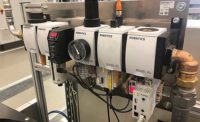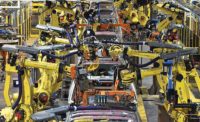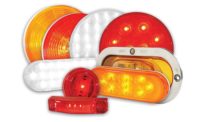Mobilized Robot Brings Hirotec Closer to Lights-out Manufacturing

A dual-arm robot, mounted on a mobile platform, performs black oxide dipping of spare parts at Hirotec America. Photo courtesy Yaskawa Motoman Inc.

This robot-platform combo is helping Hirotec America reach its goal of operating as a 24/7 lights-out manufacturer by 2025. Photo courtesy Clearpath Robotics Inc.


Being the welding equipment supplier for several of the world’s leading automotive OEMs is a big responsibility, but not an impossible one. Hirotec America (HA) is proof of that. Since 1988, the company has provided this equipment to GM, Fiat Chrysler, Ford, Toyota and BMW.
For just as long, HA has relied on its K2 philosophy to meet this ongoing challenge. K2 requires a simultaneous focus on kaizen (continuous improvement) and kaikaku (revolutionary changes in technology and process). This philosophy has also led company management to recently mandate that HA operate as a 24/7 lights-out manufacturer by 2025.
Gary Krus, vice president of business development at HA, says the plan involves several stages, beginning with automating the company’s spare parts production. This change allows spare-parts operators to be shifted to value-added tasks within the organization.
The first process in spare parts production to be automated is black oxide dipping. Parts are sequentially dipped in a series of buckets, with specific time delays between each sequence so parts become oxidized. The final parts receive a thin corrosion-resistant coating so they don’t rust.
Until this past summer, operators transported parts to the process line and performed dipping as fill-in work between their other shop tasks. If operators did not dip them with perfect timing, they would come out inconsistently. Dipping often had to be repeated multiple times on the same parts.
These inefficiencies convinced Krus and his team to automate the process. Today, a dual-arm robot, mounted on the mobile OTTO 1500 platform, transports the parts and performs all oxide dipping.
“It’s providing much more consistent parts than our manual process,” notes Peter Mourelatos, R&D project engineer at HA. “We don’t have to run the parts through multiple times anymore, which improves our productivity.”
According to Krus, the robot-platform combo unit was up and running within a day. In less than a week, it was maneuvering easily between several oxide-dipping stations.
Mourelatos likes that HA didn’t have to change any of the infrastructure in its buildings for OTTO, which is made by Clearpath Robotics Inc. Unlike a traditional AGV, the mobile platform doesn’t need to follow a preset path. It works in human-dense environments and safely travels around forklifts and operators.
“We wanted to replace a human and do the job just the way a human does it manually,” explains Kus. “OTTO gives us the flexibility we needed.”
The robot, an SDA20D from Yaskawa Motoman Inc., is a dual-arm, 15-axis robot designed for complex assembly and material handling applications, including part transfer, machine tending, and pressing or forming. Each arm has a 20-kilogram payload capacity, and a horizontal and vertical reach of 910 millimeters.
The arms can either work together or perform simultaneous independent operations. Internally routed cables and hoses (six for air and 12 for electric) reduce interference and maintenance, and ease programming. The robot’s DX100 controller supports all major fieldbus networks, including EtherNet/IP, DeviceNet and Profibus-DP.
For more information on dual-arm robots, call 937-847-6200 or visit www.motoman.com. For more information on mobile robot platforms, call 844-733-6886 or visit www.ottomotors.com.
Looking for a reprint of this article?
From high-res PDFs to custom plaques, order your copy today!








